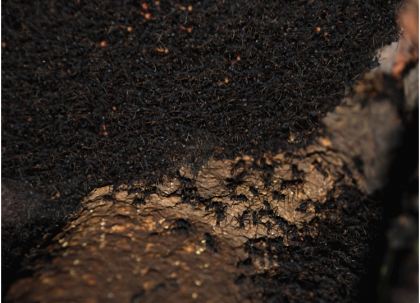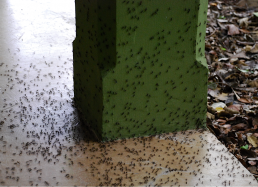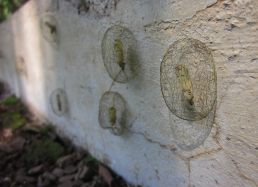Blog #5: Army Ant Reconnaissance
At times, finding Neotropical army ants can be difficult, which may be surprising considering the size of their colonies and the structure of their nest. Army ant colonies are commonly made up of a few million individuals that band together each evening after a raid to form enormous, dense bivouacs—temporary, traveling nests made up of their own livings bodies, knitted together.
Predators by nature, most army ants feed exclusively on other ant species, and sometimes other kinds of insects. Only a few species of army ants are capable of dining on larger creatures, such as small lizards and rodents. (Nope, they can’t take down a cow or a human during a swarm, contrary to the Indiana Jones movie.)
For such small critters, army ants have big appetites. Collectively, an army ant colony can eat about as much as a jaguar would. In short, army ants are top Neotropical predators, and while they’re more common than jaguars, environments can only support so many colonies—which means that it takes detective work to locate a roving band within a habitat.
Upon arriving at Area de Conservacion Guanacaste (ACG), I was delighted to hear one of the nicknames the locals had for the army ants in the region. Although commonly known as las arrieras (ants), army ants were nicknamed limpiadores (cleaners) by employees of the biological station in ACG. The name refers to the ants' habit of swarming the station's buildings in search of other ants and wasps (see Photo #1 below.) To see these ants in action, and for views of their amazing bivouac, check out my “Video Journal #3: Army Ants.”
Sure enough, the first day in the station, I found an army ant bivouac of the species Eciton burchellii (see above photo) in a pile of old plywood and other garbage. On a daily basis, hundreds of thousands of these individuals gathered outside the bivouac, and then began to swarm forage in a chosen direction. How such enormous colonies reach a unilateral group decision is still unknown, but once they’ve selected their target, they search every inch of the environment for any invertebrates or small vertebrates.
This manner of swarm foraging is amazing to watch, and intrigued Darwin (1839) as well:
"One day, at Bahia, my attention was drawn by observing many spiders, cockroaches, and other insects, and some lizards, rushing in the greatest agitation across a bare piece of ground. A little way behind, every stalk and leaf was blackened by a small ant. The swarm having crossed the bare space, divided itself and descended an old wall. By this means, many insects were fairly enclosed, and the efforts which the poor little creatures made to extricate themselves from such a death were wonderful."
Although I may not share the same morbid fascination as Darwin, the way in which the individuals cooperate with each other to capture their prey is astounding. Furthermore, they’ve become so proficient and successful at hunting in tropical rainforests that there are close to 30 species of birds that exclusively feed alongside these swarms.
As it turns out, it’s a lot easier for these birds to just swoop in and grab one of the insects running away from the army ants than it is to search for the insects alone. Though this competition reduces the army ants' “catch,” the freeloading behavior of the birds makes it easier for scientists to find ant swarms, because we can follow the birds' distinctive calls.
To learn more these army ant followers, check out "Blog #6: On the Trail," written by John Bates, an ornithologist and Field Museum curator. During his Amazonian Bird Expedition, he describes the experience of observing a mixed flock of ant specialists as they feed upon insects fleeing an advancing front of army ants.
Yet, ant birds are not the only organisms that have adapted to army ant predation. A total of 557 different species have been found to associate in some way with E. burchellii—this is the greatest number of specialists known to associate with any single army ant species! Furthermore, many prey species are believed to have evolved defensive behaviors that help guard against this style of swarm foraging, including spinning protective casings around pupae, such as those that I found on a nearby tree (see Photo #2 below.)
Interestingly, E. burchellii has also adapted and evolved to better manage a wider range of available prey. Most ant species have only one or two castes or classes—workers that forage for food and soldiers that defend the nest. But only E. burchellii has four different castes, including a “sub-major superworker” with huge jaws for dismembering large prey and longer legs for transporting a bigger catch.
One of the questions I’m studying while we’re here in Costa Rica is whether this special caste is made possible due to growth hormones triggered by the ants’ diverse diet. Or, since E. burchellii queens mate with many more males than is typical for most ant species, are the daddy’s genes determining the birth of a superworker? To learn more about these intriguing possibilities, check out my “Army Ant Antecedents” page.
Stay tuned for more blogs from my colleagues on the trip!
Max







